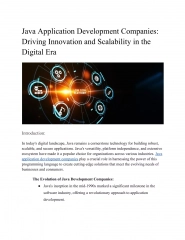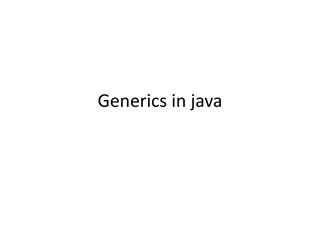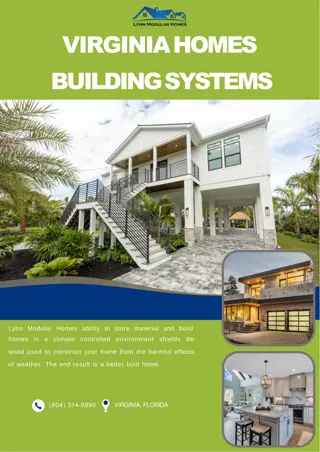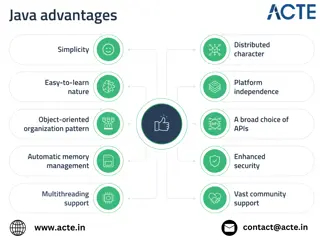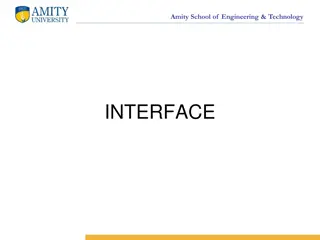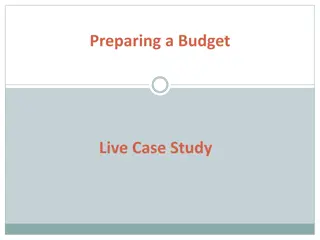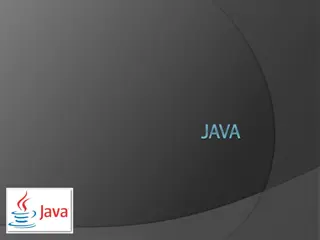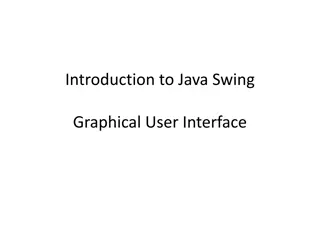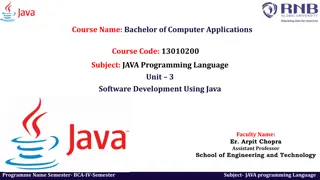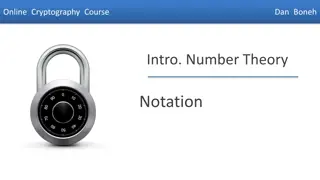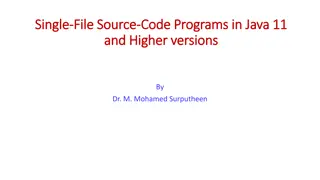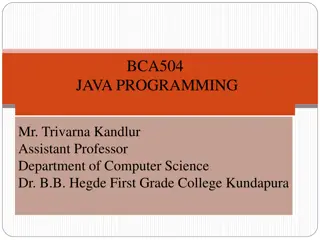Understanding OSGi Framework for Modular Java Applications
OSGi, a dynamic module system for Java, enables loading, unloading, and upgrading modules on a running system. It provides a service-oriented, component-based environment for developers, standardized software lifecycle management, and supports various application design patterns. Apache Karaf aligns with ODL and ONOS to leverage OSGi implementation, while OSGi Framework Layering offers a model to decouple bundles and manage their lifecycle without restarting the VM. OSGi modules enhance deployment with bundle-based JAR files, separate class loaders, and support for multiple versions and code boundaries.
Uploaded on Sep 08, 2024 | 0 Views
Download Presentation

Please find below an Image/Link to download the presentation.
The content on the website is provided AS IS for your information and personal use only. It may not be sold, licensed, or shared on other websites without obtaining consent from the author. Download presentation by click this link. If you encounter any issues during the download, it is possible that the publisher has removed the file from their server.
E N D
Presentation Transcript
The SENSE Project John MacAuley How to build an ENOS application macauley@es.net
Application Architecture Web Container (Jetty) Jersey Client JAX-RS Connector Web Management Console Servlet Container OSGi Runtime API OSGi Srvc Registry Application OSGi Shell Service specific API Topology Service Multipoint VPN Service Monitoring Service Policy Services perfSONA R Driver OSCARS TP Driver ScienceDMZ TP Driver ODL OSCARS Srvc Driver MonALISA Driver AuthN Services Srvc Driver ENOS Services Netshell API Interactive Shell Messaging/ Events logging Scheduler Users ACL Resources Netshell Kernel Persistence OSGi SSHD Java Python 2 9/8/2024
Why OSGi as a runtime? A dynamic module system for Java - modules can be loaded, unloaded, and upgraded on a running system Provides a service-oriented, component-based environment for developers Offers standardized ways to manage the software lifecycle of an application Runtime supports a standard set of application design patterns with built in framework features Used in projects such as Eclipse, IBM Webshpere, ODL, ONOS, and many more 3 9/8/2024
Apache Karaf ENOS utilizes the Apache Karaf OSGi implementation aligning with ODL and ONOS http://karaf.apache.org/ 4 9/8/2024
OSGi Framework Layering Provides a publish/find/bind service model to decouple bundles Service Model Manages the life cycle of a bundle in the framework without requiring the VM to be restarted Lifecycle Creates the concept of a module (aka. Bundles) Module OSGi Minimum Execution Environment (JavaSE) Execution Environment 5 9/8/2024
OSGi Modules Unit of deployment is the bundle i.e., a JAR with extra metadata Separate class loader per bundle Independent namespaces Class sharing at the Java package level Multiple version support (i.e. side-by-side versions) Explicit code boundaries and dependencies (i.e. package imports and exports) Support for various sharing policies (i.e. arbitrary version range support) Arbitrary import/export package (influence package selection) Sophisticated class space consistency model to ensure code constraints are not violated 6 9/8/2024
Maven support for OSGi Maven supports generation of OSGi compliant bundles (JAR file) through the org.apache.felix.maven-bundle-plugin 7 9/8/2024
Features repository A simple and flexible way to provision applications A feature describes an application as: a name a version an optional description (eventually with a long description) a set of bundles optionally a set configurations or configuration files optionally a set of dependency features When you install a feature, Apache Karaf installs all resources described in the feature Automatically resolves and installs all bundles, configurations, and dependency features described in the feature 8 9/8/2024
Features repository features.xml file is added to maven repository along with the JAR bundles and is used to aid in automatic feature and dependency discovery karaf@root()> feature:repo-add mvn:net.es/sense-service/1.0-SNAPSHOT/xml/features Adding feature url mvn:net.es/sense-service/1.0-SNAPSHOT/xml/features karaf@root()> feature:install sense-service SENSE service: started karaf@root()> 9 9/8/2024
Application Lifecycle Start install Installed Starting start Active Resolved stop uninstall Stopping End Uninstalled 10 9/8/2024
Participating in the lifecycle OSGi allows an application to provide hooks into the lifecycle state machine through the use of an activator 11 9/8/2024
Why do I care? Perform application initialization (start) and cleanup (stop) Register public interfaces (start) and unregister interfaces (stop) with the OSGi Service Registry Lookup service interface for needed dependencies (start) and free reference to interface (stop) Determine status of other bundles through API or via events through listener 12 9/8/2024
Inversion of Control and Annotations Inject lifecycle events, register services, or inject references to services into your existing code without having to interact directly with the OSGi framework Use the OSGi Declarative Services or iPOJO to inject through XML descriptors (inversion of control) or annotations SpringDM provides a Spring IoC compliant framework for OSGi 13 9/8/2024
Annotations 14 9/8/2024
The Service Registry The OSGi framework promotes a service oriented interaction pattern among bundles to decouple dependencies Service Registry publish find Service Provider Service Requester interact 15 9/8/2024
Manipulating the Service Registry // Add topology service to OSGi service registry. BundleContext context = getBundleContext(); ESnetTopologyIf topologyService = new ESnetTopology(); ServiceRegistration registration = context.registerService(ESnetTopologyIf.class.getName(), topologyService, null); // Lookup topology service in OSGi service registry. BundleContext context = getBundleContext(); ServiceReference ref = context.getServiceReference(ESnetTopologyIf.class.getName()); ESnetTopologyIf topologyService = (ESnetTopologyIf) context.getService(ref); 16 9/8/2024
JAX-RS Auto-wiring The OSGi JAX-RS Connector connects Jersey and OSGi at the service level OSGi services can be published as RESTful web services by simply registering them as OSGi services When the connector discovers a service that is annotated with the JAX-RS annotations @Path/@Provider it automatically hooks these services into Jersey and the OSGi HTTPService REST services can also be directly consumed as OSGi services To configure, specify the jax-rs-connector bundle, making sure the system scr and http bundles have been installed: karaf@root()> feature:install scr http karaf@root()> feature:install webconsole karaf@root()> feature:repo-add mvn:com.eclipsesource.jaxrs/features/5.3/xml/features Adding feature url mvn:com.eclipsesource.jaxrs/features/5.3/xml/features karaf@root()> feature:install jax-rs-connector karaf@root()> feature:install jax-rs-provider-moxy karaf@root()> 17 9/8/2024
Register your web service Either register the JAX-RS service directly with the OSGI Service Registry, or use one of the OSGi Declarative Services frameworks to annotate the service 18 9/8/2024
RESTful Services using JAX-RS http://localhost:8181/services/sense?name=SENSE%20Project! { "message": "Hello SENSE Project! } 19 9/8/2024
Extending the Karaf shell 20 9/8/2024
Karaf Web Console http://localhost:8181/system/console 21 9/8/2024
Starting minimum runtime Download and install Apache karaf Download and build Netshell https://github.com/esnet/netshell Download and build ENOS https://github.com/esnet/enos Configure the Netshell runtime ReadMe @ https://github.com/esnet/enos Start karaf 22 9/8/2024
Starting minimum runtime Load Web components into Karaf: karaf@root()> feature:install scr http karaf@root()> feature:install webconsole karaf@root()> feature:repo-add mvn:com.eclipsesource.jaxrs/features/5.3/xml/features karaf@root()> feature:install jax-rs-connector karaf@root()> feature:install jax-rs-provider-moxy Load Netshell and ENOS features from local maven repo into karaf: karaf@root()> feature:repo-add mvn:net.es/netshell-kernel/1.0-SNAPSHOT/xml/features karaf@root()> feature:install netshell-kernel karaf@root()> feature:install netshell-python karaf@root()> feature:repo-add mvn:net.es/enos-esnet/1.0-SNAPSHOT/xml/features karaf@root()> feature:install enos-esnet 23 9/8/2024
Topics to complete Minimum configuration to get started (i.e. I don t need ODL) Authentication and authorization for application web services within SENSE and ENOS Defining and interacting with application specific ACLs Netshell users and how they apply to applications Data persistence 24 9/8/2024


